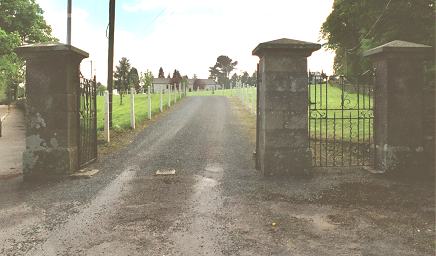Shillelagh, Co. Wicklow
Shillelagh Poor Law Union was formally declared on the 12th July 1839 and covered an area of 89 square miles. Its operation was overseen by an elected Board of Guardians, 24 in number, representing its 19 electoral divisions as listed below (figures in brackets indicate numbers of Guardians if more than one):
Co. Wicklow:
Aghold, Ballingate, Ballinglen, Ballybeg, Carnew (2), Coolballintaggart, Coolboy, Coollattin, Cronolea, Kilballyowen, Killimere, Kilpipe, Munny, Rath, Shillelagh, Tineheley (2).
Co. Carlow:
Clonegal (2), Clonmore (2), Hacketstown (2).
The Board also included 8 ex-officio Guardians, making a total of 32. The Guardians met each week at 1pm on Friday.
The population falling within the Union at the 1831 census had been 31,596 with divisions ranging in size from Munny (population 828) to Hacketstown (3,719).
The new Shillelagh union workhouse was erected in 1840-1 on a six-acre site half a mile to the south-west of Shillelagh. Designed by the Poor Law Commissioners' architect George Wilkinson, the building was based on one of his standard plans to accommodate 400 inmates. Its construction cost £5,300 plus £1,000 for fittings etc. The workhouse was declared fit for the reception of paupers on 21st December 1841, and received its first admissions on 18th February 1842.
A small block, possibly just an entrance lodge, stood at the north of the site. The main buildings followed Wilkinson's standard layout. An accommodation block facing to the east contained the Master's quarters at the centre, with male and female wings to each side. At the rear, utility rooms such as bakehouse and washhouse were connected through to the infirmary via a central spine containing the chapel and dining-hall.
During the famine in the mid-1840s, idiot wards already under construction were raised a storey to accommodate an additional 40 inmates. A fever hospital was also erected at the south of the workhouse.

Shillelagh former workhouse site from the north, 2002
© Peter Higginbotham.
In June 1920, the workhouse fever hospital was taken over for military use.
The workhouse buildings have now been demolished and the site is now occupied by a cemetery,
Records
Note: many repositories impose a closure period of up to 100 years for records identifying individuals. Before travelling a long distance, always check that the records you want to consult will be available.
- Wicklow Family History Centre, County Council Buildings, Station Road, Wicklow Town, Co. Wicklow.
Bibliography
Links
- None.
Unless otherwise indicated, this page () is copyright Peter Higginbotham. Contents may not be reproduced without permission.


